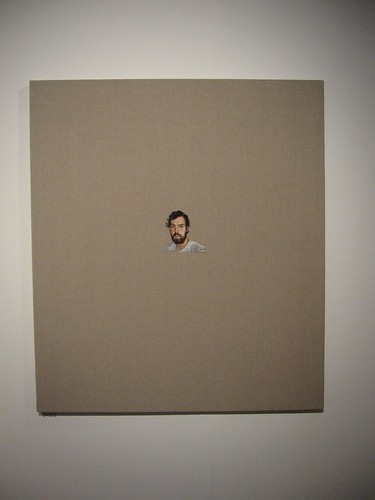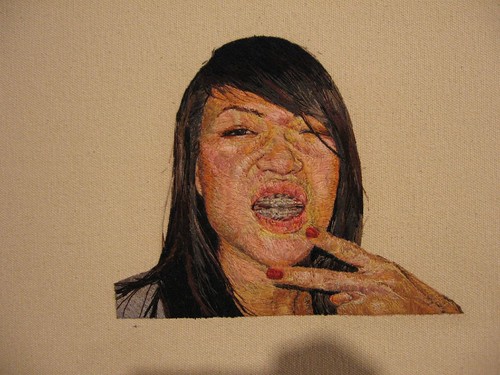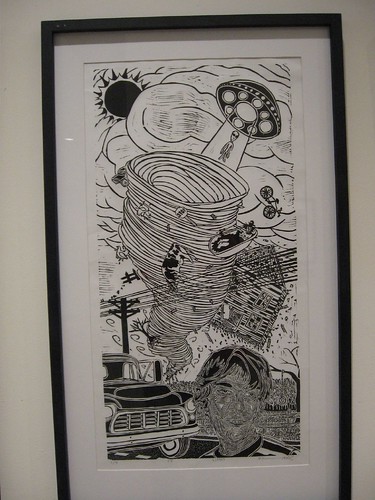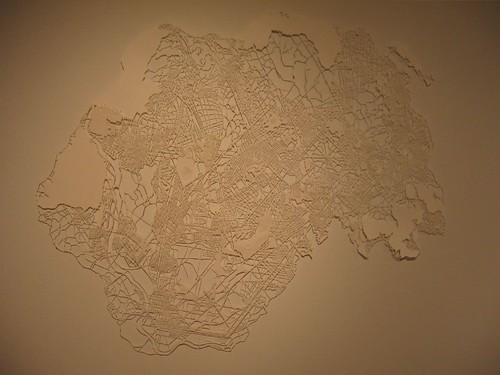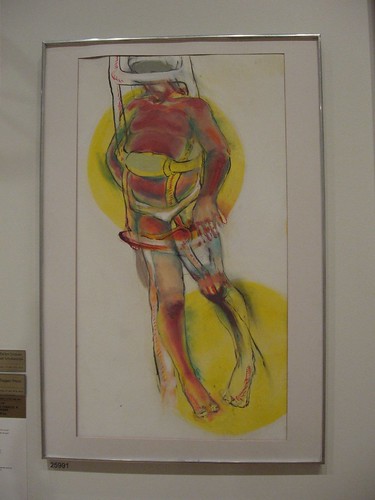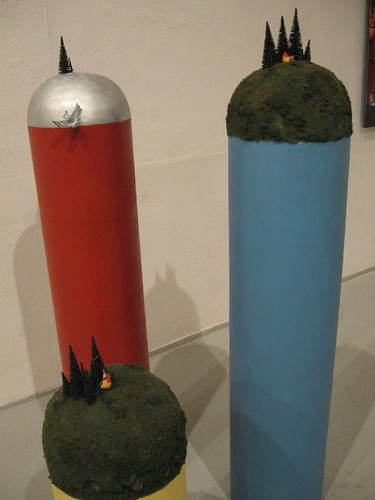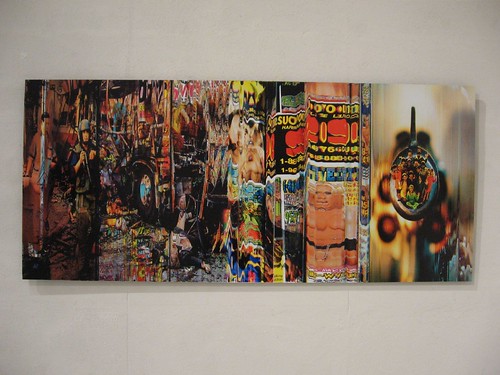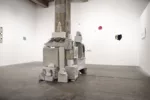
Caitlin Kuhwald and her Boy Book (still with some blank pages for the next phase in her life, I suppose) of portraits of her friends. I like this idea of archiving a social circle.
The exhibits of graduating seniors have their pluses and their minuses. They reward students who already know what they want to say and have a developed a way to say it. They can be pretty demoralizing for those who just stayed the course, did their homework and at the ripe age of 20 or 22 still are without a clue.
These latter are of course the majority.
But these latter students, whose work my eye passes over rapidly and without interest, are not necessarily not going to have great careers, plenty to say, or new ways to say it. The race is not necessarily to the swift.
What really counts for future success is often stick-to-it-iveness and enterprise. That goes for students whose work looks like something, and that goes for students whose work looks like not much going on here.
Nonetheless, since I went to see both the Pennsylvania Academy of the Fine Arts graduating students exhibition in PAFA’s Hamilton Building, and the Penn and University of Delaware MFAs at the Crane Art Center, I’ll share some of my favorites from the swift in the race.
First PAFA, which had a number of surprises.
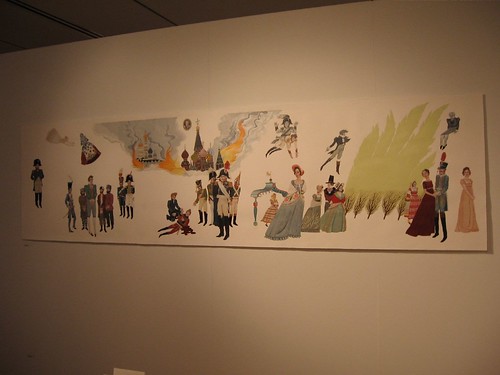
Caitlin Kuhwald, War and Peace: The Burning of Moscow, acrylic on paper. This one confirms Kuhwald’s interest in historical story telling, a perfect fit for her archiving of her current social circle. She also had a series of little doll portraits, called Best Friends. But it was the 2-D work that shone.
Caitlin Kuhwald seems to already have a network going in the Philadelphia area. We’ve seen her work before on artblog, and she’s madly drawing their portraits and lives in scroll-like and scroll-related accordian book formats. The work is quite loveable. btw, there’s going to be an auction of her work before she leaves town –the auctioneer none other than Damien Weinkrantz. Now that’s funny. (It’s June 22, 6-9, auction starts at 7, at 311 Market St., 2nd floor, at Honeymilk)
Another portraitist is Daniel Kornrumpf, who embroiders tiny faces on enormous canvases. The strategy and the technique are terrific and look awfully contemporary. The pieces make me think of how we keep reducing whole, complex works of art to tiny images both in art books and on the internet.
Here’s a closeup of another piece of his. I like the contemporary choice of the subject’s unlikely expression and gesture.
I’m going to do the rest of the images in list form as a photo post.
I liked the prints from Sam Naumick. Not only are they great to look at, but he seems to have some awareness of contemporary visual vocabulary that lifts the work out of academia.
I liked this particular piece by Stephanie Beck, which combines cut paper and maps. This is the second recent use I’ve seen of cut paper and maps–there’s a vintage London map cut-out in the middle of a doily by Meredith McNeal in Abington’s The HandMaking exhibit.
Nora Humpage uses a fluid drawing style mixed with a scary surrealism that caught my attention; the content reminded me of the recent Todt exhibit at Fleisher/Ollman. Humpage won a Cresson Memorial Travel Scholarship for her work.
I took some other pictures of work at the PAFA show that seemed to have something good going on. Here’s the set. The exhibit ends June 3.
Penn MFAs
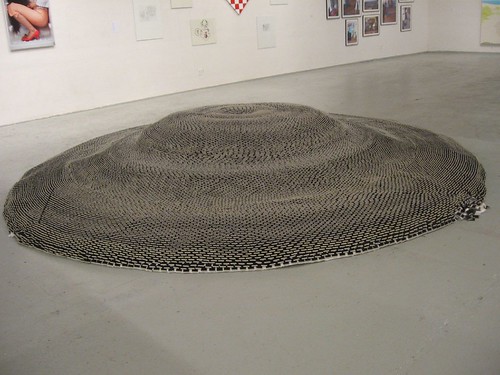
e, by Catherine Martens Betz, made of matchbooks; there’s a detail you can click over to, should you have the urge. This was really pretty swell to look at.
I saw the Penn MFA show under such trying circumstances that I’m not sure I can judge it fairly. But I want to put thank yous out to Jeremiah Misfeldt, Greg of 201 Gallery, and Nick Kripal who conspired to get the Icebox space in the Crane Arts Building open so I could look. Of course the delay, which may have soured my mood a bit, won’t stop me from flapping. So here goes.
Overall, I thought the show seemed a little tame and conventional. But there was still plenty to look at in this exhibit, curated by Arcadia University gallery Director Richard Torchia.
In sculpture, I enjoyed Catherine Martens Betz’s two pieces created by accretion of multiples of a single item–matchbooks in one, keys in the other. A special thumbs up to the matchbook mound.
I also enjoyed three sculptures by Elizabeth Peter. This one is The Silos Tend to Their Flock. Peter goes for archaic-sounding titles, but her work feels quite contemporary. She manages to be sentimental and unsentimental all at once.
Also in this exhibit was Alexis Granwell’s Navigating the Ecstasy I & II, a pink explosion of wall innards that was at Tower Gallery recently (Roberta’s post here).
I liked the baroque overkill of Clay Neigher’s giant montages of cultural excess that look like they’re straight out of Asia. But Asia is not the subject. This one is called The Bus Exploded on the way to Disneyland.

This is Where I put my Blackface, by Kristen Gayle
I liked this video by Kristen Gayle. The whole video was this exaggerated grin with a soundtrack of wild applause. The racial content is devastating. Another video by Gayle of bouncing breast-like shapes (stuffed stockings???) went on for a ponderous 7 minutes. This would have kept its mystery and some humor if it were 15 seconds.
A standout work for emotional intensity was a-three video installation, Preparations, by Lissa Corona. The part pictured above, called Lay Low, is almost Warholian, with the artist looking anxious, crouching behind her husband as he implacably brushes his teeth. My fave was Messenger, another of the three. On the verge of tears, Corona expresses all the ways she hopes she will be remembered–“Tell them …I was always the life of the party. …I want them to be proud of me,” and so forth. Occasionally “My insides are rotten” flashes across the bottom of the screen.
Francesca Pfister’s Subterranean Space series of photos were wonderful to look at. The lighting was great. The metaphoric implications of body innards was nice. And it also made me think of Jeff Wall, not just for his Invisible Man photograph, but for the nether-world in so much of his oeuvre. Pfister finds the beauty in these unsightly spaces. Pfister also showed videos of kitchen work, with a terrific soundtrack of amplified kitchen noises. Unlike the still photographs, however, videos did not provide layers of meaning.
Some other images from the Penn MFAs are on my Flickr set here.
The exhibit ends June 3.
I also stopped for a look at the University of Delaware exhibit, also at the Crane Arts Center, but a criticism session was in progress when I arrived, so I really didn’t get much of a chance to see stuff.


